[Front page] [Contents] [Previous] [Next] |
Optimization of PVC-free materials in cables
4. Material Properties
4.1 Test Plan
4.2 Selection of Materials
4.3 Test Results
4.3.1 Experimental
4.3.2 Dry Ageing Tests
4.3.3 Wet Ageing Tests
4.3.3.1 Water pH 7
4.3.3.2 Water pH 4
4.3.4 Oil Ageing Tests
4.3.4.1 Effect of Cross Linking on Oil Resistance
4.3.5 Ageing in Cable Vaseline
4.3.6 Ozone Resistance
4.3.7 Stress Cracking Test
4.3.8 UV Ageing Test
4.3.9 Burning Properties
4.3.10 Processing Properties
4.4 Discussion of Results
4.5 Selection of Compounds for Further Studies
Cable materials are normally characterized by an excellent long term stability which together with good mechanical properties secure a long cable service life regardless whether or not the end use will be indoor or outdoor under the influence of UV light, water or other environmental factors. PVC has a long and well established successful history as a cable material. It is necessary to specify and document corresponding requirements for other materials before they can be recommended for the use in cables.
The HFFR materials are far from being as well evaluated. Standards already exist with requirements for the short term properties supplemented with very mild ageing tests which in no way qualify materials for practical outdoor use. Thus we have found it necessary to set up a test programme which really gives information about the long term properties.
Part of the test programme originates from the results obtained during the previous project, but it has been changed at some critical points e.g. an oil ageing test at 50°C has been added. In this way we get a better impression of the possibilities of using the materials in contact with oil and vaseline.
We have chosen to perform dry ageing at high temperature to make sure that the basic resistance to thermal ageing/oxidation is acceptable.
Ageing test in water at pH 4 and pH 7 have been carried out in order to simulate the environment for cables buried in the ground. The experience from the previous project in fact was that degradation in wet ground conditions seemed to happen faster than in the laboratory water so new tests simulating the burial of cables under different soil conditions, or even better actual test on cables buried in the ground are needed. It has not been possible during this project to put cable samples in the ground. However, we needed to carry out the ageing test in water.
This time we have neglected the salt water test which turned out to be less severe than the test in tap water at pH 7.
The ozone test is traditionally carried out for rubber compounds and polymers with unsaturated groups which are sensitive to ozone but this test is specified for HFFR sheathed cables also.
Stress crack resistance is also a traditional test carried out due to stress cracking problems in polyethylenes many years ago. When new and comparatively unknown materials are introduced this test is still considered essential.
Testing under the influence of UV light is necessary in order to make sure that cable sheathings can resist the climatic condition when the cables are stored or used outdoor and do not degrade too fast.
For the evaluation of the influence of ageing on the materials the change in mechanical properties are used as parameters for characterisation. Important information can also be obtained from measuring the weight change of test samples after ageing in the different media.
4.1 Test Plan
The 15 originally selected compounds have been tested according to the following sceme:
Long Term Properties
Dry ageing in heat ovens at 100 and 120°C.
Ageing in water at pH 4 at 20, 50, 65, 80 and 95°C.
Ageing in water at pH 7 at 20, 50, 65, 80 and 95°C.
Ageing in ASTM no. 2 oil at 20, 50, 80 and 100°C.
Ageing in cable vaseline at 20, 50 and 80°C for selected compounds.
Ozon test according to Cenelec HD 22.2 S2. Test period prolonged compared to the standard.
Environmental stress corrosion test according to ASTM 1693 in Antarox CO-630 solution, 10%.
Ageing in QUV Test chamber using the following cycle: 20 hours UV light followed by a 4 hour water condensation period.
Burning Properties
Measurement of Limiting Oxygen Index (LOI) according to ASTM 2863 and modified LOI, the latter giving better correspondence with actual fire tests.
Smoke corrosivity test according to IEC 754-2.
Flame propagation test according to IEC 332-1 and IEC 332-3-C ("small" and "big" IEC fire test). These tests are performed only on cable samples produced in part 2 i.e. with the especially selected compounds.
Smoke density according to IEC 1034.
4.2 Selection of Materials
During the previously mentioned project four materials, designated 54003, 80465, 80476 and 80260 were evaluated.
The one with the highest flame retardancy, 54003, turned out to have an extremely low resistance towards ageing in water, the flame retardance properties of 80465 were too low for use in an optical cable construction with flammable core to pass the IEC 332-3-C fire test, 80476 which had very good long term ageing properties was too difficult to extrude on existing machinery and 80260 was not stable enough towards UV radiation.
These results suggested that a larger number of compounds had to be examined in order to secure that the compounds which were best suited for the application were included in the programme. It was of course also of interest to evaluate the results of the ongoing development work carried out by the material suppliers.
After a survey of the available raw materials, 16 compounds were selected. In the following they will be referred to by the numbers from 1 to 16.
No. 1-3. The first three materials are not commercially available compounds. They are test compounds produced by NKT Cables i.e. with known composition and included in the test programme due to that reason, so conclusions taking the composition into account can be drawn from the results obtained with these materials.
The remaining compounds are all commercially available and only very limited information of the actual formulations are available to us for these compounds.
No. 4. Selected because it fulfills VDE 0207 HM 4 specification and has a reasonable price.
No. 5. Based on polypropylene and is therefore expected to have a very good performance in wet environments.
No. 6. This was selected because of promising data sheet values, price and the possibility to crosslink the compounds chemically. Crosslinked material should have better resistance towards agressive media.
No. 7. Interesting product with claimed good processing properties combined with high content of flame retardant filler and good UV stability.
No. 8. Black compound, should therefore be well suited for outdoor use (UV stability).
No. 9. An easy processing compound with a low degree of flame retardancy and very low price.
No. 10. This compound was selected due to stated good resistance towards water and high temperatures.
No. 11. A widely used compound with a good combination of properties.
No. 12. This material was the only non black compound with a high UV stabilisation. Further, it had good merits with regard to acid resistance which gives good possibility for use in wet areas also.
No. 13. Claimed properties close to those of compound no. 14, but with lower filler content and better processing properties.
No. 14. This material is identical to material 80476 from project 1, which showed very good long term properties and low price level. It is included again and dealt with especially in the processing part.
No. 15. Included due to the very good resistance towards water.
No. 16. A substitute for 54003 in project 1. Highly flame retarded but expensive. It is included as it may be the only candidate in a cable construction that can pass the IEC 332-3-C test as a cable jacket around a flammable core.
No. 17. Two crosslinkable materials have also been selected for testing in oil. One of those is material no. 6 but crosslinked, and the other is a material especially developed for use at high temperature but good chemical resistance is also expected.
18. As a reference a standard cable PVC compound has partly been included in the test programme.

4.3 Test Results
4.3.1 Experimental
The compound test samples were extruded on a Brabender Extrusiograph (lab. measuring extruder). Approximately 1mm thick bands were extruded through a slit die at the temperature recommended for the compound by the suppliers. Afterwards standard tensile dump-bells were punched from the bands.
All of the compounds, except material no. 5, were succesfully extruded with a smooth surface and homogeneous appearance. No. 5, however, turned out to cause two problems. Firstly a very unpleasant smell from the hot compound and secondly the band looked rough with brown dots in the surface.
The samples were then aged in the different media and tested at predetermined intervals. As a standard the tensile strength (TS) and the elongation at break (EB) were measured and also the weight change of the samples after different immersion times in the individual media was measured.
The ozone and stress cracking tests were completed as previously described (section 4.1).
Based on the results obtained from the ageing tests each material was given a mark between 1 and 6 for each test environment in order to simplify the ranking of the compounds which will be carried out, see table 4.
4.3.2 Dry Ageing Tests
The results of the dry ageing tests are shown in appendix 1.1 to 1.6 for the whole
range of HFFR compounds. As a failure criteria the elongation at break value below 100 %
or tensile strength value below 10 MPa were used. The resistance to dry ageing of all the
compounds was excellent.
Only in one case, material no. 1 at 120°C after 40 weeks ageing, was a low value found,
i.e. elongation at break was 92%, just below the limit. Because of the lack of observed
failures it is not possible to extrapolate the life times at low temperature from the
accelerated heat oven tests. We can just note that the retained mechanical properties
after 40 weeks’ ageing at more than 100°C are very good.
In typical specifications 10 days at 100 or 110°C is considered satisfactory. Dry ageing
tests of two standard PVC cable compounds show that the 100% EB is typically reached after
approximately 100-200 days at 110°C, see appendix 1.6.
Two materials, nos. 9 and 13, were only tested at 100°C because their melting point was
lower than 120°C.
The results confirm the conclusion of project 1, i.e. the thermal stability of all the
compounds is good enough to secure the cable reliability for applications with no contact
to harsh chemicals i.e. normal indoor use. For indoor use the expected lifetime of HFFR
materials even seems longer than that of standard PVC compounds, depending on the thermal
load.
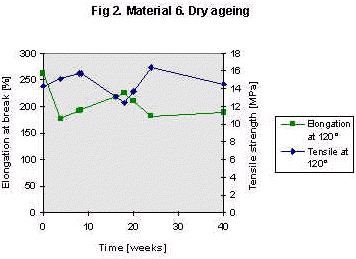
Fig. 2. Typical ageing plot
4.3.3 Wet Ageing Tests
High priority has been given to the tests in water because it is considered necessary to find materials with a good chance of a long service life in wet soil. Ageing has been carried out in water at pH 7 and pH 4 at 20, 50, 65, 80, and 95°C. Ageing times from 0 to 40 weeks. The degradation was evaluated by measuring the tensile strength as well as the weight change.
4.3.3.1 Water pH 7
All the results from the water ageing at pH 7 are shown in appendices 2.1 to 2.17. Contradictory to the dry ageing this test series shows remarkable differences in resistance to water, pH 7.
Already at 20°C failures are observed. After 8 weeks material no. 7 has virtually no elongation at break left and after 28 weeks the same is the case for material no. 10, which among other things was selected due to its claimed good water performance. Material no. 16 failed after approximately 15 weeks. These compounds cannot be used under wet conditions.
At 50 °C the compounds nos. 1 and 8 show unacceptable resistance towards the water. Material no. 8 would have been a nice choice for general outside use but the water resistance is inadequate. A common feature for the four mentioned materials is that the filler is Mg(OH)2, which also during project 1 seemed to be connected to inadequate water performance.
At 65°C also material no. 4 fails with low EB after 4-8 weeks.
Material no. 15 has reached its limit at 80°C and at this temperature nos. 6 and 11 are also marginal.
Compounds nos. 3 and 12 cannot resist water at 95°C but the remaining materials nos. 2, 5, 9, 13, 14 and standard PVC still have acceptable mechanical properties after 40 weeks ageing at 95°C in water at pH 7.
The water absorption measurements are also shown in appendix 2. Attempts to correlate the amount of absorbed water with the decrease in mechanical properties were not successfull. We have cases where the elongation at break is low for a sample with a small amount of absorbed water and also the opposite i.e. a significant weight increase resulting in no mechanical degradation has been seen.
As an example of the water ageing fig 3 and 4 show the degradation of materials nos. 7 and 14 in water at pH 7 at 20 and 95°C, respectively. Fast degradation is observed at 20°C for no. 7 while no. 14 is still shows very good value after 40 weeks at 95°C. Note that this is revealed by the elongation at break (fig 4) but not the tensile strength results (fig 3).
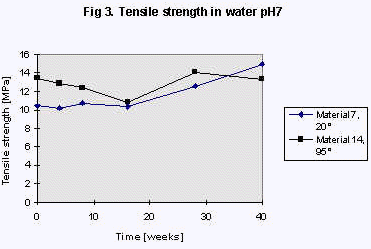
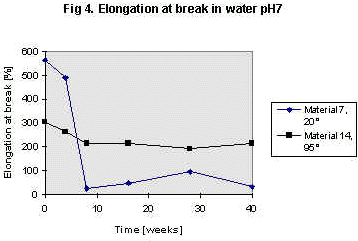
4.3.3.2 Water pH 4
An identical test programme has been carried out in water with a buffered pH value of 4. The results are shown in appendices 3.1 to 3.15.
The compounds can be divided into two groups with regard to "behaviour" in water at pH 4.
For the first group no difference is seen between the two pH values. This group includes the following compounds nos. 2, 3, 4, 5, 6, 7, 9, 13 and 14. In the other group three materials behave very differently in the two media, nos. 1, 8 and 10 are very stable in pH 4 and very unstable in pH 7 water. The remaining nos. 11, 12 and 15 are a little more stable in pH 4 than in water at pH 7.
The reason that for some materials water at pH 4 is a more "healthy environment" than water at pH 7 can be linked to the actual pH, but since the acidity seems to be an advantage we find it more likely that the ionic strength or osmoticity is an important factor. A concentration of solutes e.g. as found in the pH 4 solution simply lowers the activity of the water molecules and thus the resistance of the compound is improved. Again the effect seems to be present for the compounds that contain Mg(OH)2 in particular.
Fig 5 shows the behaviour of compound no. 8 in the two different media at 50 and 80°C, respectively.
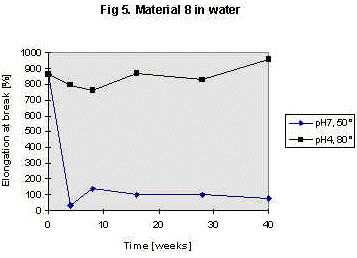
Concluding the water tests it can be stated that just like for PVC compounds it is possible to find HFFR compounds that can survive 40 weeks in water at 95°C and different pH values. These materials can be used as sheathing compounds for cables in wet areas with a good possibility of a long service life.
4.3.4 Oil Ageing Tests
The oil ageing tests were performed in a similar manner to the water ageing tests with ASTM oil no. 2 replacing the water. The maximum test time was again 40 weeks, and the strength as well as the oil absorption/extraction values were measured. The results are shown in appendices 4.1 to 4.19.
At 20°C, all the compounds show very good mechanical properties. Materials nos. 1, 5, 7, 8, 13, 14 and 15 have survived 40 weeks with property changes below 20%. The remaining materials have changes between 20 and 40% except no. 11 which has an EB below half of the original value but still well above 100%. All the materials had oil absorptions around 5-10% by weight after 40 weeks, except no. 15 which absorbed only 2% by weight. Strangely enough material no. 15 had been chosen due to its acclaimed water resistance but in oil it showed an exceptionally low absorption.
Already this low temperature test suggests that all the materials are acceptable for non-permanent oil contact applications and some even for long time in contact with a moderately agressive test oil.
At 50°C, the oil absorption level is increased but now it varies very much from one compound to the other, the lowest being 10% (material no. 15) and the highest absorption 54%. The tensile properties retained are still acceptable for most compounds, the standard PVC compound included. After 40 weeks all EB values are above 100%. Some have become rather week, however, especially
nos. 11 and 16 with approx. 25% of their original tensile strength left. Material no. 15 still shows exceptional values after ageing at 50°C.
The 80°C test lasted only one week because of failure of the equipment. However, the duration was long enough to show that some materials simply dissolve in ASTM no. 2 oil when they get close to their crystalline melting point. Some compounds retain marginal strength. These are nos. 5 (because it is polypropylene based), 10, 14 and 15, which nearly behave like a cross linked material retaining a very high tensile strength.
The test at 100°C gave similar results showing that nos. 5, 10 and 15 are still behaving like polymer materials even after 28 weeks exposure.
If we compare with standard cable PVC compounds we typically see that after one week at 95°C their EB drops near to 0 while the strength is doubled. Both these observations are due to loss of plasticizer but show that the best HFFR materials clearly match the standard PVC with respect to oil resistance.
Special oil resistant PVC compounds exist which give much better results as the plasticizer is non-migrating. These types are more expensive and often stiffer than standard PVC compound and consequently only used when really required.
Concluding the results of the oil tests we may say that both standard HFFR and PVC materials have a reasonable resistance towards immersion in ASTM test oil no. 2. In both types of compounds especially developed compounds exist that will preform for a longer time with permanent oil contact.
4.3.4.1 Effect of Cross Linking on Oil Resistance
Some of the HFFR compounds have a polymer composition which makes chemical cross linking possible. By cross linking it is possible to form a 3-dimensional molecular network which is normally assumed to give better mechanical and thermal properties as well as chemical resistance than in corresponding thermoplastic material. The disadvantage from an environmental point of view is that recycling of cross linked materials is not possible.
As the cross linking process of the compounds chosen in this project is of the socalled silane cross linking type, the processing itself is also more problematic because it involves the addition of a catalyst masterbatch (granules or liquid) before extrusion, and a treatment in hot water or steam afterwards in order to obtain a proper cure stage.
Material no. 6 was cross linked by this method as well as a 17th compound especially designed for silane cross linking. A hot set test made at 200°C showed that for both compounds the cross linking reaction was succesfully carried out.
The results from the ageing tests are shown in appendix 4.19.
The results obtained for no. 6 show that cross linking has an effect on the oil resistance. Fig. 6 shows the degradation of cured and uncured samples of material no. 6 in ASTM Oil no. 2 at 65°C. The uncured sample loses nearly all its tensile strength while the cured sample retains about 30% of the original strength.
Sample no. 17 (appendix. 4.19) shows an oil resistance as good as the best thermoplastic materials above but not more than what had been accomplished by carrying out the cross linking process.
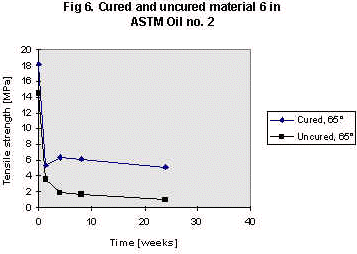
The theoretical advantages of cross linked materials have been verified by the experiment with compound no. 6, but no real advantage has been achieved in comparison with the best compounds from the group tested. Consequently, it was chosen not to continue the evaluation of cross linked materials in this project.
4.3.5 Ageing in Cable Vaseline
In order to make communication cables water tight they are often filled with cable vaseline (petro jellies). These consist of natural hydrocarbon oils thickened with microcrystalline wax and in project 1 "Alternative to PVC in cables and connected building installations" the materials tested were non compatible with vaseline except for material 80476 (no. 14 in this project). The test temperatures were 20 and 80°C then, this time we also have carried out measurements at 50°C.
Only four materials were tested in vaseline. These being the most interesting compounds based upon an overall evaluation of the properties, i.e. materials nos. 6, 9, 11 and 14. The results (see appendix 5.1 to 5.4.) do not differ very much from those which were observed in the oil ageing tests. Good stability at 20 and 50°C and degradation after short time at 80°C except for no. 14 which after 40 weeks at 80°C has retained above 10 MPa in TS and 86% in EB.
Thus it seems that it is safe to use no. 14 in jelly filled cables and probably also nos. 6 and 11 based upon the good results obtained at 50°C. No. 9 should probably be avoided for this use because of a rather high absorption (11% at 20 and 28 at 50°C).
Fig . 7 shows the decrease in tensile strength for compound no. 11 as a function of time and temperature.
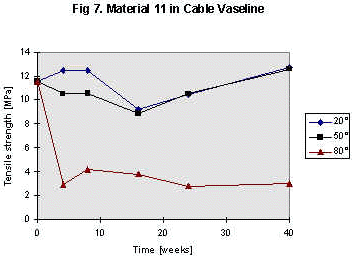
4.3.6 Ozone Resistance
Ozone is present in atmospheric air in small amounts and in certain environments in larger amounts. Ozone is a very reactive gas, especially towards double bonds in some polymers causing chain breakdown.
Standards exist which specify the requirement of a certain ozone resistance for vulcanized cable compounds and also for the HFFR materials even if the polymer used are without double bonds.
Stressed samples of the compounds are placed in an atmosphere with 200 ppm ozone for 14 days (normal requirement is 40 hours) and later on inspected for any sign of cracks. One of the samples, material no. 7, had small surface cracks but none of the others showed any sign of complete damage.
4.3.7 Stress Cracking Test
The tendency of the materials to environmental stress cracking has been tested according to the "Bell Test", ASTM 1693. Stressed samples are placed in contact with a 10% Antarox CO-630 solution at 50°C and examined for the formation of cracks.
None of the samples showed any sign of stress cracking.
4.3.8 UV Ageing Test
Accelerated UV ageing and weathering was performed with the selected materials. The QUV Tester used was equipped with UV 340 lamps with a spectral distribution very close to that of sunlight. The test cycle used was 20 hours UV light at a black panel temperature of 60°C followed by a 4 hour water condensation period at a black panel temperature of 50°C. Based on experience with different plastic materials an acceleration factor of about 50 is assumed (compared to Northern European Climate).
Preliminary test
The test samples were extruded bands of materials nos. 1-15 without addition of colour masterbatch. The ageing was again measured by the decrease in tensile strength. The first samples were examined after 4 weeks exposure and the last ones after 43 weeks. The results are given in appendix 6.
Large differences between the individual compounds were observed. Nos. 6, 10 and 14 were below 100% in EB already after 4 weeks, followed by nos. 1, 7 and 11 (5-10 weeks). The next group of compounds were nos. 2, 3, 4 and 15 which failed to fulfil the criteria between 10 and 28 weeks while nos. 5, 9 and 13 lasted more than 28 weeks before the 100% EB/10MPa TS criteria was passed. The two remaining materials nos. 8 and 12 were both OK after 43 weeks ageing corresponding to something like 40 years of outside service if the assumed acceleration factor is correct.
These two materials are good candidates for permanent outdoor use. They are also the only two which were UV stabilized by the supplier, no. 8 being black and no. 12 containing a stabilization package which made colouration of the compound difficult due the compound’s initial colour.
Evaluation of addition of stabilizers
In order to investigate the effect of UV stabilizing additives we have selected material no. 14 for further examination. This material exhibits the best overall property profile except the stability against UV irradiation which is very bad thus offering a good opportunity for testing the additives.
Material no. 14 was tested during UV irradiation in 5 formulations
1. Without additives.
2. With an addition of 2% blue colour masterbatch.
3. With 2% blue and 1% HALS (Hindered Amine Light Stabilizer).
4. Same as 3 + 0.5% UV absorber.
5. With 2% blue and 1% of another HALS type.
The results are given in fig. 8.
The results are very clear. The unstabilized version of the compound is, as in the preliminary test, degraded after 5 weeks (EB 21%) while all the others are OK even after 38 weeks corresponding to nearly 40 years. So it seems that just the addition of colour pigment is enough to obtain good stability against UV irradiation.
Experiences from other areas indicate that such long term extrapolations are always dangerous and therefore it is advisable always to add a UV stabilizing additive for permanent outdoor applications. It is also doubtful whether or not all pigments offer the same protective effect as the blue pigment tested. We assume that the observations made for material no. 14 are general, but of course it will be necessary to carry out a test against UV irradiation with the actual compound to be used.
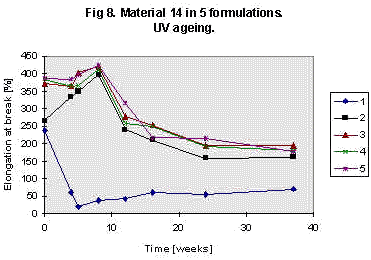
Tests on standard PVC compounds in a grey colouration show that EB 100% is passed after 7-12 weeks. But it is known that a cable sheath based on such a PVC compound will typically last 20 years before getting brittle. Based on the QUV tests we would expect UV-stabilized HFFR types to be at least as good as standard PVC which has been in use for outdoor use for many years.
4.3.9 Burning Properties
The Limiting Oxygen Index (LOI) has been determind for all the compounds as well as the "modified" LOI value using a proprietary method which gives better correspondence with actual fire tests behaviour than the traditional LOI measurement. The higher the LOI value, the smaller is the tendency to support a flame in a fire situation.
Also the corrosivity of the smoke has been tested according to IEC 754-2, which requires a pH value higher than 4.3 and a conductivity lower than 100µS/cm in the wash water from the smoke test.
Results from the fire tests in table 1.
TABLE 1
FIRE PROPERTIES |
||||
Compound |
LOI % |
LOI mod. |
pH |
Conductivity, µs/cm IEC 754-2 |
1 |
35 |
27 |
- |
- |
2 |
33 |
- |
- |
- |
3 |
34 |
28 |
- |
- |
4 |
35 |
28 |
5.4 |
18 |
5 |
43 |
29 |
7.7 |
2500 |
6 |
40 |
32 |
5.7 |
20 |
7 |
48 |
26 |
5.4 |
26 |
8 |
36 |
26 |
- |
- |
9 |
40 |
27 |
- |
- |
10 |
27 |
23 |
4.1 |
25 |
11 |
47 |
30 |
5.4 |
26 |
12 |
31 |
24 |
5.5 |
30 |
13 |
35 |
22 |
- |
- |
14 |
38 |
29 |
5.7 |
16 |
15 |
30 |
25 |
5.6 |
36 |
16 |
49 |
34 |
4.3* |
40* |
PVC |
- |
- |
fail |
fail |
* Data from supplier’s data sheet.
From the results above it is obvious that the fire retardancy judged by the LOI value varies a lot from one compound to the other. Using the modified LOI for ignitability, however, we see minor differences, but still we can see different levels of ignitability. Material no. 16 is clearly the best (i.e. the most difficult to ignite). Then we have an intermediate group and at last a group with very low fire retardancy consisting of nos. 10, 12, 13 and 15.
The corrosivity tests show that all the HFFR materials tested, except no. 5, easily pass the two requirements. Material no. 5 is probably retarded with ammonia polyphosphates explaining why the smoke conductivity is so high.
4.3.10 Processing Properties
Initial measurements of the melt viscosity have been carried out on a measuring extruder, see chapter 5.3. Based upon these measurements the individual compounds can be classified with regard to processability.
4.4 Discussion of Results
In table 2 we have tried to give an overall view of the test results mentioned previously. For the long term tests we have found it convenient to characterize the ability to withstand the influence of given environment conditions by a number between 1 and 6. 1 representing a totally unsuited material for the actual end use and 6 the best choice for permanent use under those environmental conditions. In this way we have an easy method for selecting the best material for a given end use. For the more detailed evaluation and the possible life time predictions, it is necessary as the next step to consider the degradation graphs given in the appendices.
Below the methods for characterizing the properties by marks are described.
Ageing in heat oven
6 is given if no changes in properties are observed after 40 weeks at 120 and 100°C,
respectively.
If the tensile strength (TS) is still above 10 MPa and the elongation at break (EB) still
better than 100% a mark of 5 is given.
Because of the good results it was unnecessary to use marks below 5.
Ageing in water
6: TS above 10 MPa and EB above 100% after 40 weeks at 95°C.
5: Same requirement after 40 weeks at 80°C.
4: Same requirement after 40 weeks at 65°C.
3: Same requirement after 40 weeks at 50°C
2: Same requirement after 40 weeks at 20°C
1: Failure before 40 weeks at 20°C.
Ageing in ASTM oil no. 2
An evaluation is given for each of the temperatures tested.
6: No change in TS and EB after 40 weeks
5: Changes below 20% compared to original values.
4: Changes between 20 and 40%.
3: Changes above 40%.
2: Material strongly degraded but still coherent and measurable.
1: Material disintegrated and not measurable in a tensile test.
Ageing in the QUV apparature.
6: No changes in TS, EB and surface glosss after 40 weeks in QUV Tester.
5: Changes below 20% and surface gloss intact after 28 weeks.
4: EB above 100% after 28 weeks but surface degraded.
3: EB below 100% within 10-28 weeks.
2: EB below 100% within 5-10 weeks
1: EB below 100% before 5 weeks.
Concerning processability the compounds are classified according to viscosity level measured at 100 s-1 at processing temperature.
6: Viscosity below 500 Pas
5: Viscosity from 500 to 1000 Pas
4: Viscosity from 1000 to 1500 Pas
3: Viscosity from 1500 to 2000 Pas
2: Viscosity from 2000 to 2500 Pas
1: Viscosity above 2500 Pas.
The results from the fire and smoke tests in table 1 are simply given as "pass" or "fail" according to the relevant standard test procedure.
As stated in table 2 and in the preceeding paragraphs there are great variations between the individual compounds. Some have extremely good properties in one respect and very poor properties in another. We have a compound with excellent stability to oil at high temperature, one with excellent UV stability and several with excellent resistance to water. None of the compounds are optimal in every respect but neither is PVC. It is in fact possible to find a compound with as good overall properties as PVC and, naturally, improved fire performance.
TABLE 2 : Look here
* The UV results (except for nos. 8 and 12) are for uncoloured and unstabilized compounds. See results for stabilized versions in section 4.3.8.
4.5 Selection of Compounds for Further Studies
Based upon the results from the material test programme 3 compounds with overall acceptable general properties have been selected for further study of the processing properties and for the production of different test cables and finally fire testing.
The selection process follows a stepwise exclusion method as follows:
1. The first requirement is that the compound must be commercially available. Hereby we can exclude materials nos. 1, 2 and 3 which are all development products.
2. The next general requirement is that the fire retarding properties must be sufficiently high. Our best criteria before making real fire tests is the determination of modified LOI value. Values below 26 we characterize as low, 27-32 medium, and values >33 as highly fire retardant materials. Setting the limit to 26% minimum we can exclude the compounds nos. 10, 12, 13 and 15. Still remaining are nos. 4, 5, 6, 7, 8, 9, 11 and 14.
3. Another basic requirement is that the combustion smoke must fulfil the corrosivity specifications in IEC 754-2. Compound no. 5 which maybe has the best overall properties, clearly exceeds these requirements and must be excluded. In fact it turned out later on in the project that this compound is still to be considered as a developmental product due to the inhomogeneities described in 4.3.1.
4. Of the remaining 7 materials nos. 4, 7 and 8 showed rather bad resistance to water at different temperatures. This made the application for buried cables very doubtful and thus these compounds are excluded.
5. The level of fire retardancy of compound no. 9 is significantly lower than for nos. 6, 11 and 14. For this reason we chose nos. 6, 11 and 14 in spite of the good overall properties of compound no. 9.
6. We have 3 compounds left. As stated in table 2 the UV stability of these compounds are unacceptable. For this reason UV tests with coloured and stabilized versions of compound no. 14 have been carried out and the results look that good that permanent outdoor use seems realistic (fig. 8). We believe that this result will also be valid for the other HFFR compounds.
Compound no. 14 is superior to the other two regarding contact to water, vaseline and oil. Expecting extrusion difficulties with no. 14 we have found it necessary to include also nos. 6 and 11 for further studies. These two, especially no. 11, should be more easily processable.
The price level for the three materials is at the lower end which is also an important parameter.
In the following parts of the report the processability of the HFFR compounds are treated with special focus on the three selected compounds.
[Front page] [Contents] [Previous] [Next] [Top] |